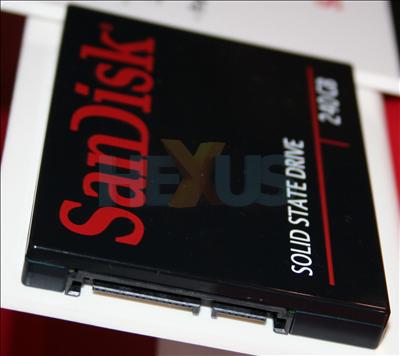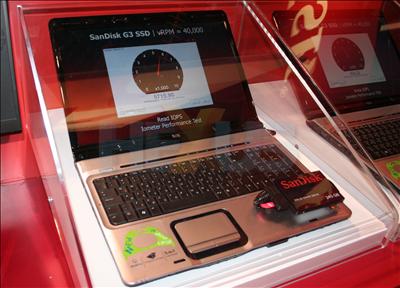SanDisk to unleash 240GB SSD with 40,000vrpm
|
by Tarinder Sandhu
on 10 January 2009, 18:19
Tags:
SanDisk (NASDAQ:SNDK)
Quick Link: HEXUS.net/qaqnu
Add to My Vault:
|
|
Being a memory manufacturer that specialises in flash media, it was no surprise to see the company launch faster versions of its diminutive microSDHC and M2 cards.
Dubbed Ultra now, the 4/8/16GB models, available in both form factors, promise faster speeds, but SanDisk wouldn't tell us by how much.
Expect to pay $119.95 for the 16GB and $129.99 for the same-capacity M2, and both include a MobileMate USB reader. Now I could do with the latter for my ageing Sony Ericcson K800i phone.
New SSDs
SanDisk was also showing off third-generation SSDs (solid-state drives) that will become available in mid-2009.
To be released in capacities of 60GB, 120GB and 240GB, with prices already set at $149, $249, and $499, respectively, the G3 drives will ship in both 2.5in and 1.8in form factors, interfacing via the usual SATA connector.
What's interesting is that SanDisk will also be releasing the 2.5in drives with a PATA connector, thereby offering a user upgrade for older laptops.
The G3s will have a sequential read/write speed of 200MBs/140MBs, but SanDisk's reps were keen to point out that sequential transfers aren't indicative of true SSD performance.
Rather, the company has developed an in-house benchmark dubbed vRPM (virtual revolutions per minute), and attributed a figure of 40,000vrpm to the G3 line.
vRPM attempts to quantify the effective rpm rating of an SSD such that Joe Average can understand it. SSDs, of course, don't have moving parts so the vRPM is an approximation of the kind of rotational speed, SanDisk reckons, a traditional hard drive would need to run at to match the SSD's overall performance. You can find out more here.
SSDs are significantly faster at small-size random reads and writes, and this is where most of the vRPM calculation is derived from. For example, SanDisk showed the 240GB drive performing around 450 4KB random write IOPS, which is some 6x faster than traditional hard drives, according to the company.
Whatever the math, SSDs make implicit sense in notebooks once they become cheap enough. I reckon that 'cheapness' barrier will be crossed in 2009, sooner rather than later, and SanDisk's G3s look decent enough on paper.
When will we see the first 100,000vrpm drives, I wonder, and, for the sake of pragmatism, let's hope this quasi-standard doesn't stick.
Click here for all CES 2009 content.









